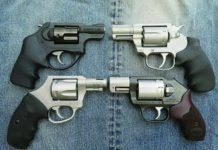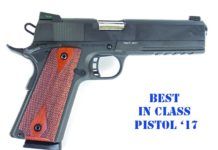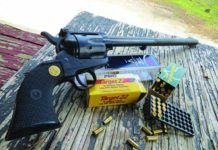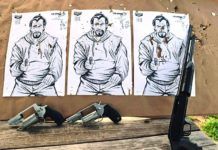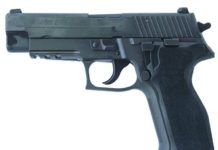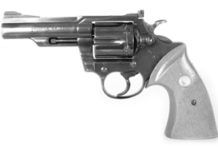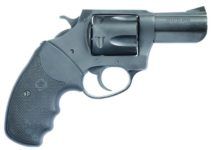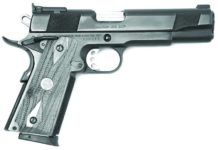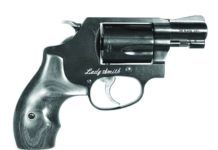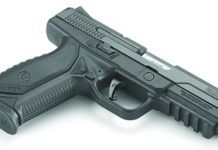New Revolvers from Kimber, Charter Arms, Ruger, and Colt
Why are there so many snubnose revolvers being manufactured? There is no sign that big-bore snubnose revolvers are going away any time soon, especially with manufacturers introducing new snubnoses. Snubnose wheelguns have been and are still excellent choices for self-defense sidearms. Easy to use, no magazine to lose, and chambered in powerful calibers, revolvers are here to stay. So we took a look at four new snubnose revolvers: the Charter Arms Boomer, Ruger's LCRx, the Kimber K6s CDP, and the Colt Cobra. These snubnose revolvers all proved to be reliable, safe, consistent, and accurate for self defense. What we experienced with these revolvers was a variety of grip sizes, some of which our testers said were too small for comfortable shooting or they were too big for ideal concealed carry.
The sights on three guns were very serviceable, while one didn't have sights at all. The triggers separated the pack, as did the chamberings. Two used a double-action-to-single-action trigger and two featured a double-action-only (DAO) trigger. A revolver chambered in 357 Magnum offers convenience because it can shoot 38 Special ammo, too. After tallying the scores, in our opinion the Ruger LCRx is a good choice for concealed carry, though we would tweak it. The Charter Arms Boomer, Kimber K6s, and Colt Cobra are all pretty good choices, but as you will see, the devil is in the details on those three.
We tested at 10 yards because these snubnose revolvers are made for concealed carry and short-range encounters. But we learned 10 yards was too far if you don't have sights, so we accuracy tested the Charter Arms Boomer at 7 yards. Not having sights is a liability as the distance between you and a bad actor increases. Though we typically test at 25 yards, FBI data shows that most gunfights between an officer and an attacker occur from a distance of 0 to 5 feet apart. We concealed-carry citizens can expect the same. The reality is these revolvers are made for up-close work. Short sight radii, smallish grips, and DA triggers do not make for tack-driving accuracy.
We also carried these revolvers in inside-the-waistband (IWB) and appendix-carry-style holsters. We took the time to practice our draw and dry-fire these revolvers at an imagined bad actor a few steps away. On the range, we tested for accuracy using a rest. The DA/SA trigger mode on the LCRx and Colt provided an edge over the DAO models. We also tested a variety of ammunition, and the K6s and LCRx proved to be more practical and versatile because they can fire both 38 Special and 357 Magnum cartridges. Here's what we thought about each handgun in more detail.
New Cimarron Firearms: SHOT Show 2018
Here's a behind-the-scenes look (literally) at Cimarron's new-product offerings for 2018.
2017 Guns & Gear Top Picks
Toward the end of each year, I survey the work R.K. Campbell, Roger Eckstine, Austin Miller, Robert Sadowski, David Tannahill, Tracey Taylor, John Taylor, and Ralph Winingham have done in Gun Tests, with an eye toward selecting guns, accessories, and ammunition the magazine's testers have endorsed. From these evaluations I pick the best from a full year's worth of tests and distill recommendations for readers, who often use them as shopping guides. These choices are a mixture of our original tests and other information I've compiled during the year. After we roll high-rated test products into long-term testing, I keep tabs on how those guns do, and if the firearms and accessories continue performing well, then I have confidence including them in this wrap-up.
A Trio of Unusual Revolvers: Worth the Trouble and Money?
Most gun owners want firearms they can shoot and have fun with, even their life-and-death carry guns. Some of us also want the unusual because we like a walk on the wild side, irrespective of whether it has any use beyond messing around with or plinking. In this Special Report, we take a look at three wheelguns for which there are little or no match ups to find, so head-to-head testing isn't possible. But even without something to shoot beside them, we can learn plenty about whether some unique, or nearly unique, handguns are worth the time and trouble to find and add to your collection as a real, firing item.
Herewith then, we look at the Nagant M1895 7.62x38mmR, the Smith & Wesson Model 929 9mm Luger, and the Chiappa Buntline 22 LR.
.410 Bore Self-Defense Choices
The decision of which self-defense .410 firearm is the correct choice for up-close-and-personal situations encountered in the home often comes down to a handgun in one hand or a short-barreled pump-action shotgun in the other. Because of their ease of handling, two revolvers that are capable of firing both .410 loads and handgun rounds are becoming quite popular; and pistol-grip short-barrel shotguns remain a favored option in self-defense circles. The question arises about which type of close-range firearm is the most effective with the diminutive .410 loads, including those that have recently been developed with short-barreled revolvers in mind.
Acting on a reader request, we conducted a multitude of tests on a trio of readily available self-defense firearms that included a Taurus Judge (handles .410-bore shotshells and 45 Colt) that retails for $629; a Smith & Wesson Governor (handles .410, 45 Colt, and 45 ACP) that retails for $809; and a Mossberg Model 500 Cruiser that sells for $467 and fires .410-bore shotshells.
Each of the firearms (all have been examined in previous GT reviews) is specifically designed for close-quarters action, such as when an intruder has illegally entered a residence, placing the people living in the home in a potentially life-threatening situation. In such a life-or-death scenario, a reliable, easy-to-handle, and effective self-defense tool is essential.
In this part of the GT evaluation and match-up, our focus was on the handling ability of the three firearms and their patterning performance at close-quarters ranges. We attempted to walk the fine line that divides ease of handling with putting the pattern in the right place to evaluate the two revolvers and the pump-action.
We tested the firearms on the range with targets set at two ranges used in concealed carry courses to simulate typical home-defense scenarios. The close targets were set at 9 feet (3 yards) and the second set of targets was shot at 21 feet (7 yards). Here are our findings.
2016 Guns & Gear Top Picks
Toward the end of each year, I survey the work R.K. Campbell, Roger Eckstine, Austin Miller, Robert Sadowski, David Tannahill, Tracey Taylor, John Taylor, Rafael Urista, and Ralph Winingham have done in Gun Tests, with an eye toward selecting guns, accessories, and ammunition the magazine's testers have endorsed. From these evaluations I pick the best from a full year's worth of tests and distill recommendations for readers, who often use them as shopping guides. These choices are a mixture of our original tests and other information I've compiled during the year. After we roll high-rated test products into long-term testing, I keep tabs on how those guns do, and if the firearms and accessories continue performing well, then I have confidence including them in this wrap-up.
Smith & Wesson 638 Bodyguard .38 Special +P
The name Bodyguard has to be one of the all-time classic names for a self-defense gun. Certainly this Smith & Wesson design has been with us a long time, and in many ways it should be considered an unsung hero among the latest super-light firearms, mainly because it did so much so well.
Colt Trooper Mark III .357 Magnum
The Colt Trooper was made from 1953 to 1969. The Trooper Mark III superceded the Trooper and had a redesigned lock mechanism. It was manufactured from 1969 to 1983 in blue and nickel finish with 4-, 6-, and 8-inch barrel lengths. An owner's manual can be obtained by calling Colt at (800) 962-2658. The Trooper III in our test was made in 1974.
The Colt Trooper Mark III is for all practical purposes the working man's Python. Sound good? It features a serrated front sight pinned in place. The rear sight is fully adjustable, and it should be more durable than similar designs since the rear notch moves back and forth inside a protective frame. While adjustment for elevation is clockwise for down and counter-clockwise for up, the windage adjustment is reversed. Turn it to the right if you want the point of impact to move left, and turn left to bring the POI to the right.
Another feature is the direction in which the cylinder rotates. While other revolvers move counterclockwise, expecting a Colt to go bang requires the first round to be in the 11 o'clock position prior to cycling. Also, to release the cylinder one pulls rather than pushes on the latch.
Snubbies, the Taurus Recall, and Trump on Guns
Regarding the Taurus settlement and the problems Lou had with his pistol: On August 4, 2015 I sent Taurus my PT-111 Pro and two magazines. Their website was very poor about updating progress of the return, but by 12/16/2015 I did have a new PT-111 G2 with two mags, all new in the box. I had to pay $25 for the FFL transfer fee, but I was reimbursed by 1/15/16. I am actually quite pleased with the new gun. To get reimbursed, I faxed an itemized receipt to Taurus at (305) 624-1126. I hope this helps Lou and perhaps others.
More Laments for Custom Guns
Like Grant said in last month's letters section, I, too, lament the passing of the pride of custom-gun ownership and the common look of the Ubiquitous Black Gun. But, as was said, black guns are cheap and proven reliable. Also, I cannot justify carrying a nice custom pistol on the off chance that I might have to use it. In that case, I would have to surrender it to the police, and then it would be months at a minimum to maybe get it back by jumping through their hoops.
Yes, I would rather carry a "Rolex"-quality sidearm, but I often think that if I had to give up my Valtro, I'd don't know what I'd do.
A black gun I can give up with no emotion, and go home and get another one. I always enjoy the magazine, from the editorial remarks to the last page. — Dave
Revolvers for the Elderly, New Virginia Laws, Henry Rifles
In last month's Firing Line, reader Winslow asks for advice on a 357 magnum lightweight snubnose revolver for a 75-year-old female cousin. I would appreciate a little help. I'm wondering why these two diametrically opposed 308s were chosen to oppose one another. While I am not in one of the affected states, I am from Vermont, and we do not require a permit for CC, and no state recognizes our not needing a permit! Whatever happened to the personal pride everyone took in their ownership of not only a working tool, but also a masterpiece of design and artwork?
I have read recent Gun Tests articles on various AR rifles, so I recently built an AR with a folding stock. I was attracted to this option because I drive a sports car, and even with a collapsible stock and 16-inch barrel, an AR will not fit in the trunk. The folding stock adapter I chose was one made by Law Tactical (LawTactical.com). It was easy to install, works fine to fold the stock, and adds just a little bit of fiddling when I have to separate the upper and lower. But it is very expensive and adds no additional operating functionality to the firearm, since it should never be fired with the stock folded. Anyway, I have not seen many options for folding stocks on an AR platform, and thought that a review of adapters for them might be in order.
Sturm, Ruger Rolls Out Significant New Pistols, Revolvers, and Rifles
Sturm, Ruger & Co., Inc. has announced a new line of full-size duty pistols, new chamberings for its GP100 revolvers, new barrels for its 10/22 Takedowns, and new colors for its Lite rimfire pistols. Also, the company has added a Takedown rifle to its SR-556 line. The Ruger American Pistol will be available in 9mm Luger and .45 Auto. The two 9mms are Model Nos. 8605 (17+1) and 8607 (10+1) and the 45 is Model No. 8615, and all will list for $579 MSRP.
The Ruger American Pistol is built on a one-piece precision-machined stainless-steel chassis with integral frame rails and fire control housing. It has a black nitrided finish, Novak LoMount Carry three-dot sights, a stainless steel slide with non-reflective black-nitride finish, and a one-piece glass-filled nylon grip frame. The front accepts accessories on a mil-standard 1913 rail.
"The Ruger American Pistol is the most advanced semi-auto pistol we have ever produced," noted Ruger CEO Mike Fifer.
The 9mm weighs in at 30 ounces with a 4.2-inch barrel and the .45 weighs in at 31.5 ounces with a 4.5-inch barrel. Both ship in a hard case with replaceable grip modules and two, nickel-Teflon plated steel magazines. Capacities are 17 rounds for 9mm and 10 rounds for .45 Auto. 10-round magazines are also available for the 9mm for those states which restrict round counts.
CEO Fifer said that Ruger polled law enforcement and military trainers throughout the country to determine the form, function, and features of this firearm. The new pistol combines a recoil-reducing barrel cam to spread recoil over time, a low-mass slide, low center of gravity and a low bore axis to provide better balance, less felt recoil and less muzzle flip.






























